Gymnosporangium juniperi-virginianae
Rusts are fungi that will not kill their hosts, although they sure make them suffer. There is even a term for pathogens that require living hosts: biotrophs (in contrast to necrotrophs, pathogens that kill their host and live off the dead tissue).
Think Gloria Gaynor – your plants will survive! However, repeated infections of this pathogen can seriously weaken and destroy the health of susceptible plants. They will also lose any ornamental value.
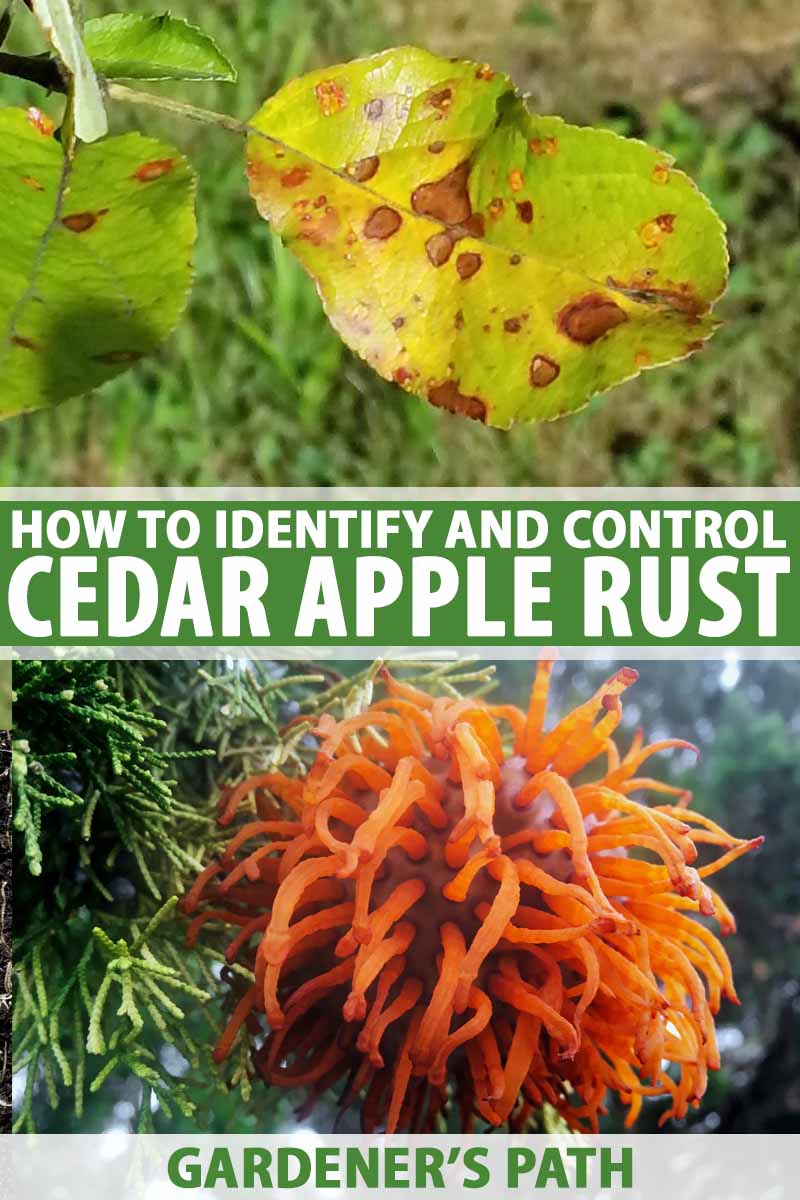
We link to vendors to help you find relevant products. If you buy from one of our links, we may earn a commission.
Read on to learn how to identify and control cedar apple rust in your garden or home orchard.
What You Will Learn
What Is Cedar Apple Rust?
Cedar apple rust (Gymnosporangium juniperi-virginianae) is a fungal disease that depends on two species to spread and develop.
It spends a portion of its two-year life cycle on Eastern red cedar (Juniperus virginiana).
The pathogen’s spores develop in late fall on the juniper as a reddish-brown gall on young branches of the trees.
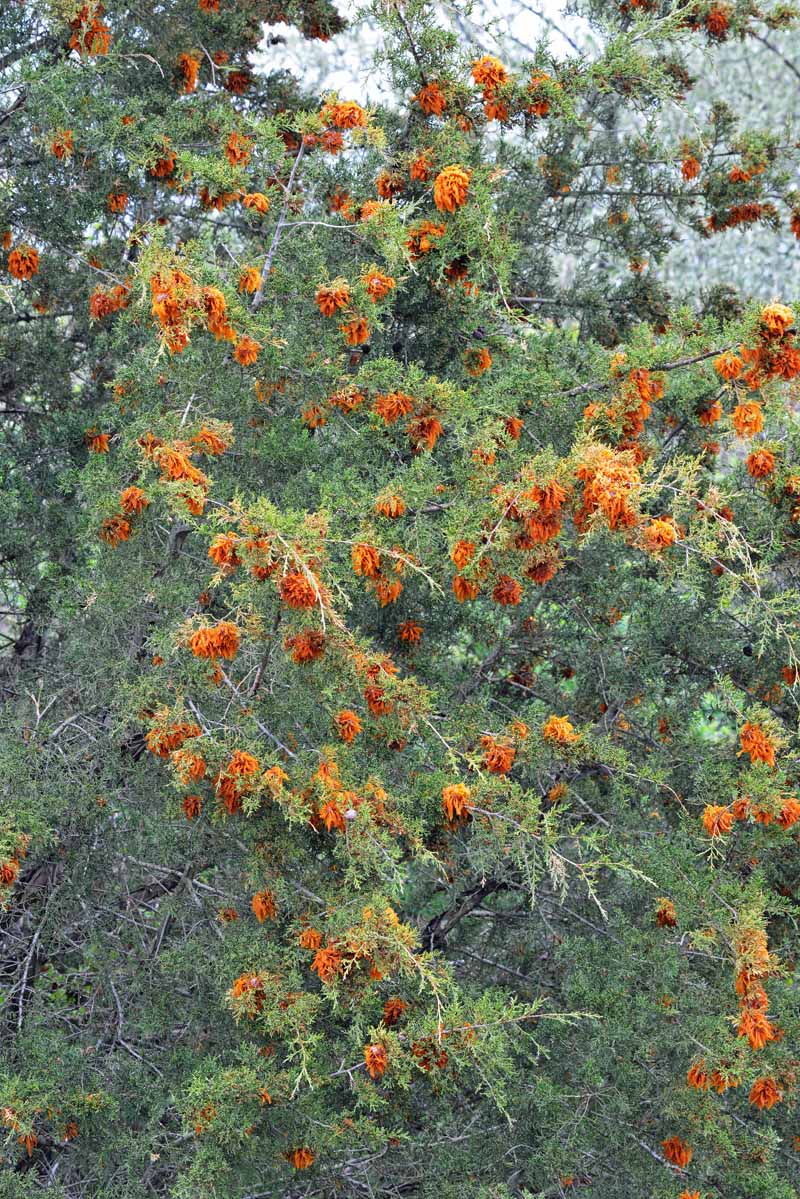
As the spring showers begin, the galls grow and release spores, which are carried by the wind to infect apple and crabapple trees. There, they develop into a disease that causes red spots to occur on the leaves, and that can deform the fruit.
The damage done to the leaves greatly affects the apple trees’ ability to gather sunlight and nutrients from the air, damaging its health and fruit production, and in some cases causing death.
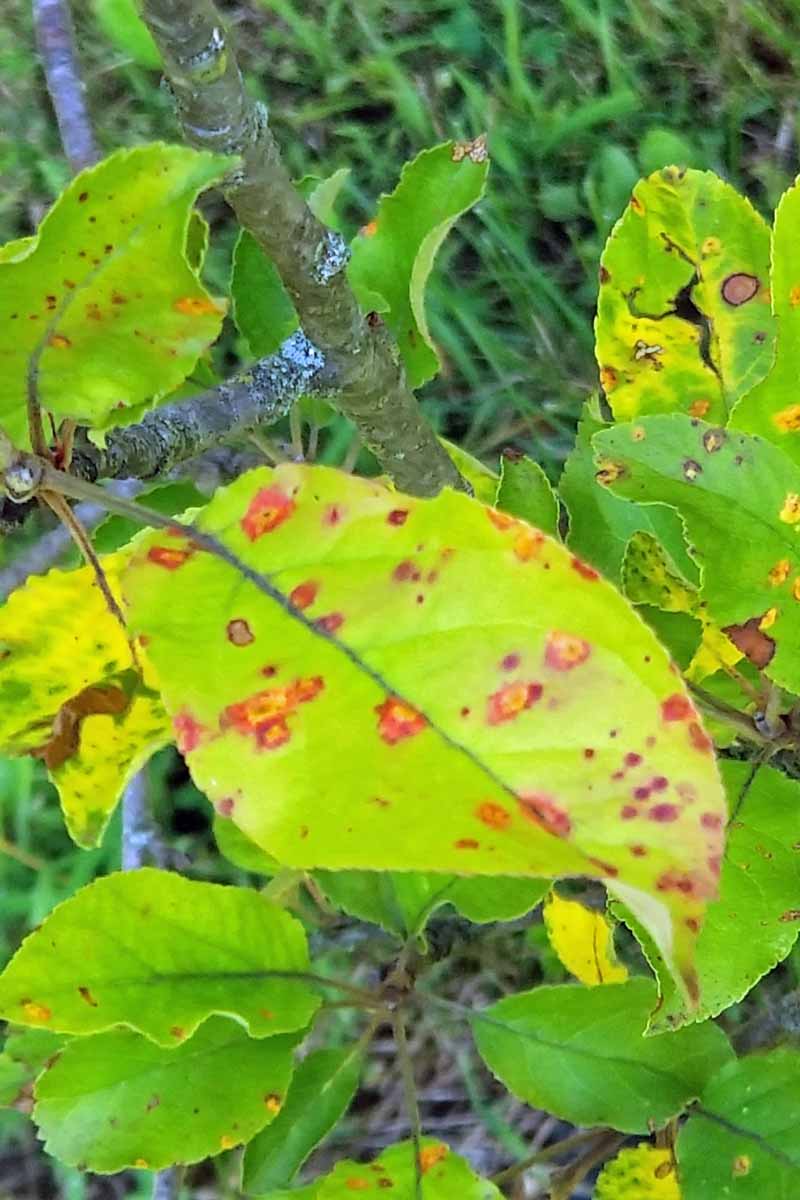
The fungus cannot be transferred from apple tree to apple tree, or from juniper to juniper.
The following year, spores are released from the apple trees that, in turn, infect the junipers.
The disease is extremely prolific during wet years.
Note that this is a simplified explanation. Gymnosporangium juniperi-virginianae actually produces FIVE different kinds of spores.
When a Cedar Is not a Cedar
All native American cedars, including Western and Eastern varieties, are not true cedars. They are actually a form of juniper. True cedars are native to hot and arid Mediterranean locations such as Lebanon and Cyprus, and the Himalayas.
Both are conifers and belong to the taxonomic Pinales order. But the American natives belong to the the cypress family (Cupressaceae) while the true varieties are of the pine family (Pinaceae).
True cedars have fan-like foliage and produce small cones or pink flowers, while junipers have rough textured bark similar to that of many hardwoods, and they usually have scale-like leaves and reddish stringy bark.
Symptoms on Juniper
This fungal pathogen starts life on junipers as an aeciospore that the wind carries from apples to its new host in the late spring or early fall. A brown gall develops the following summer and fall.

During the spring rains 18 months later comes a metamorphosis that rivals that of Kafka’s. Instead of turning into a cockroach, the galls swell and grow spurs called telial horns that are brown at first but turn bright orange in the rain.
Apple cedar rust is straight out of the disco era with its large galls and radically orange telial horns that protrude in all directions. To make them even more outrageous, the telia are gelatinous.
If conditions are right, these telial horns produce another type of spore that produces yet another kind of spore, which is blown back to infect apple leaves and fruit. As few as 4-5 hours of rain at 50-75°F is time enough to produce a severe infection on apples.
Symptoms on Apples and Crabapples
Instead of galls, infected apple and crabapple trees manifest circular yellow spots on the upper surface of their leaves soon after bloom. Later in the summer, brownish cylindrical tubes with hairs sticking out appear underneath the yellow spots, or on the twigs and fruit.
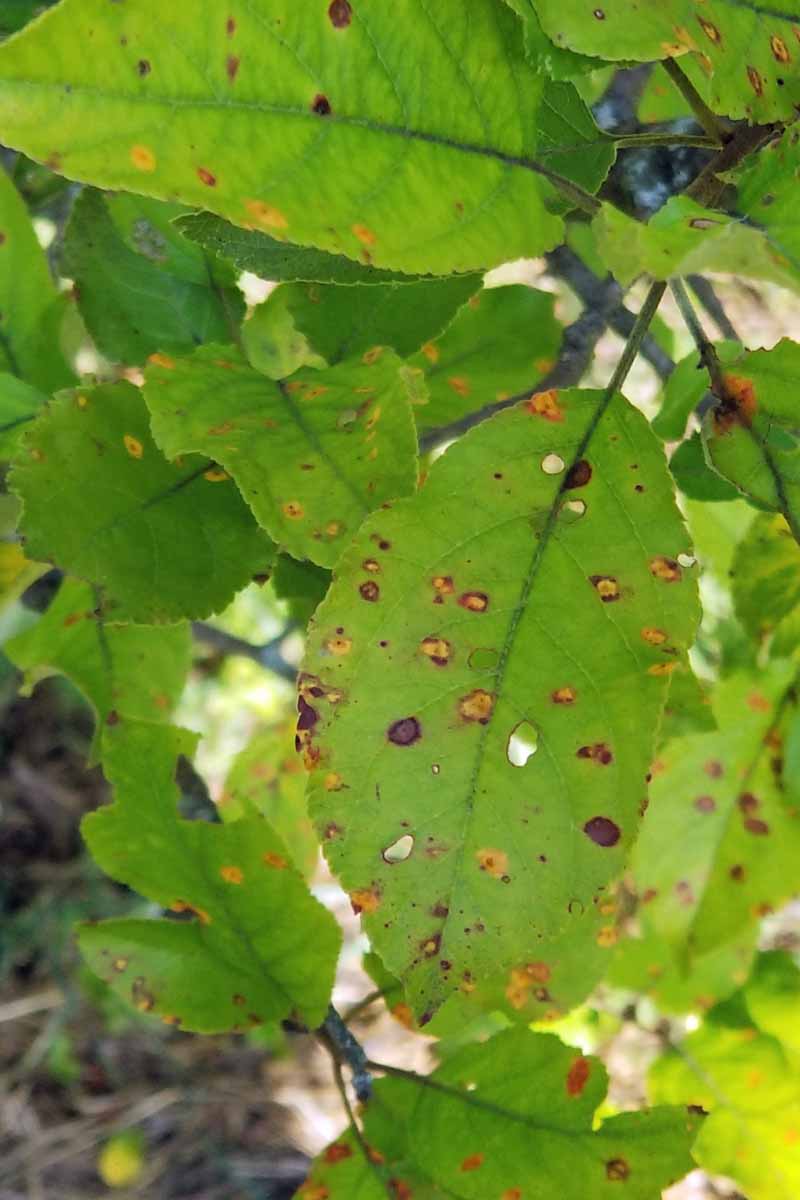
These tubes produce the aeciospores that will complete the cycle by infecting the needles of junipers.
At the least, the infected fruit may be of marginal quality. Worst case scenario – they drop off the tree.
In addition, a severe infection can cause your tree to drop its leaves! If that happens for several years in a row, your apple tree could be in peril.
How to Control Cedar Apple Rust
The best way to control cedar apple rust is to prevent infection using a mixture of cultural methods and chemical treatments.
If you see the lesions on the apple leaves or fruit, it is too late to control the fungus. In that case, you should focus on purging infected leaves and fruit from around your tree.

Don’t plant junipers near rust-susceptible plants, which include both apples and crabapples. Consider resistant apple varieties, such as ‘Freedom,’ ‘Liberty,’ ‘Redfree,’ or ‘William’s Pride.’
And also destroy wild or unwanted apples, crabapples, or junipers, so they won’t infect your apple tree.
Cultural Controls
Since the juniper galls are the source of the spores that infect the apple trees, cutting them is a sound strategy if there aren’t too many of them.
While the spores can travel for miles, most of the ones that could infect your tree are within a few hundred feet.
The best way to do this is to prune the branches about 4-6 inches below the galls.
You will want to disinfect your pruning shears, so you don’t spread the infection. Dip them in 10% bleach or alcohol for at least 30 seconds between cuts.
Fungicide Treatments
If your tree has a history of infection with cedar apple rust, you will want to get ahead of the infection and take preemptive measures.
This is critical in the spring, when the juniper galls are releasing their spores.
The time to treat your tree is between the pink stage of the blossoms (when the leaves are turning green) to the period when the petals drop.
The most effective types of fungicides to use are those that inhibit fungal sterols. They are known as “SI,” or sterol inhibitors.
In the old days, sprays for apple scab would also take care of cedar apple rust. However, this is no longer the case.
The fungus that causes apple scab is now frequently resistant to the sterol-inhibiting fungicides, and manufacturers have moved on to using newer classes of fungicides. Only certain types of fungicides are effective.
Extension agents at North Carolina State University attribute this trend to an increase in occurrences on apple trees in the state.
Unfortunately, captan, the fungicide in many pre-mixed sprays for home fruit trees, does not work on this particular fungal pathogen.
Several extension agencies recommend that you use Immunox® to control cedar apple rust. It contains myclobutanil as its active ingredient.

Spectracide Immunox Multi-Purpose Fungicide Concentrate via Amazon
Make sure you choose a formulation that is labeled for use on fruit trees such as the one shown above, since several types available today are not designed for this purpose.
Typically, you should spray every 7-10 days during the period of infection. After that, you no longer need to treat your tree for the rest of the year.
Organic Controls
You have several options if you want to avoid using traditional fungicides on your apple tree.
Biofungicides
There is a strain of bacteria that is effective at treating cedar apple rust on apple trees.
It is a special strain of Bacillus subtilis, sold commercially as CEASE Biological Fungicide, available at Arbico Organics.
CEASE Biological Fungicide (Bacillus subtilis) via ARBICO Organics
One plus of this treatment is that it is nontoxic to beneficial insects and honeybees.
A Mixture of Sulfur and Pyrethins
These two classic compounds are available in a pre-mixed spray known as Bonide® Orchard Spray.
This spray controls both fungi and insects and is certified organic. Beware that it can harm beneficial insects in the area along with pests.
BONIDE® Citrus, Fruit & Nut Orchard Spray via ARBICO Organics
Be sure to spray all parts of your tree – especially the new leaves.
Liquid Copper
You can treat them with a solution of copper at least four times. Use 0.5 to 2.0 ounces of copper per gallon of water.

It’s best to start with this treatment as a preventative early in the spring before the trees show signs of infection, or just as they begin showing symptoms.
BONIDE® Liquid Copper Fungicide
Copper is not a cure-all, but it can help in preventing damage to the leaves and fruit.
You can find this product in most farm and home stores (such as Tractor Supply) or you can purchase it through ARBICO Organics.
Should You Treat Junipers?
Although the galls don’t do much damage to junipers, treating them with fungicide can help prevent their spores from spreading. This can also help to reduce the amount of cedar apple rust on your tree.
The time to treat the junipers is before the galls produce their teliohorns, or when they are producing the aeciospores.
You can treat them with a liquid copper product like you would with apple trees.
Unfortunately, you need to treat them repeatedly from mid-summer until fall, which can be expensive.
Other Fungal Rusts
Additional rusts plague apples and crabapples in addition to other types of fruit. These other fungal diseases have life cycles similar to that of cedar apple rust, but their telial phases are less dramatic.
Cedar-hawthorn rust (Gymnosporangium globosum) affects pear, serviceberry, and quince.
Additional alternate hosts include Rocky Mountain juniper, common juniper, and prostrate juniper. Its telial phase is short and stubby, and its spots on apple or crabapple leaves are initially yellow and then turn orange.
Cedar-quince rust (G. clavipes) affects many plants in the rose family.
Additional alternate hosts include common juniper, prostrate juniper, Rocky Mountain juniper, and savin juniper. In this case, the galls are much less noticeable – basically swellings on the juniper twigs. The telial phase looks like oozing orange scum.
And unlike the other rusts, the cedar-quince fungus typically infects thorns, new twigs, and fruits on its fruit host. These infections are much less dramatic, too, with spots that are barely noticeable.
Try as They Might, These Fungi Cannot Hide
One of the few good things about these fungi, except that they rarely kill your plants outright, is that they are really hard to miss. You will know when you see those orange telial horns on junipers that you should work on protecting your apple or crabapple tree right away.
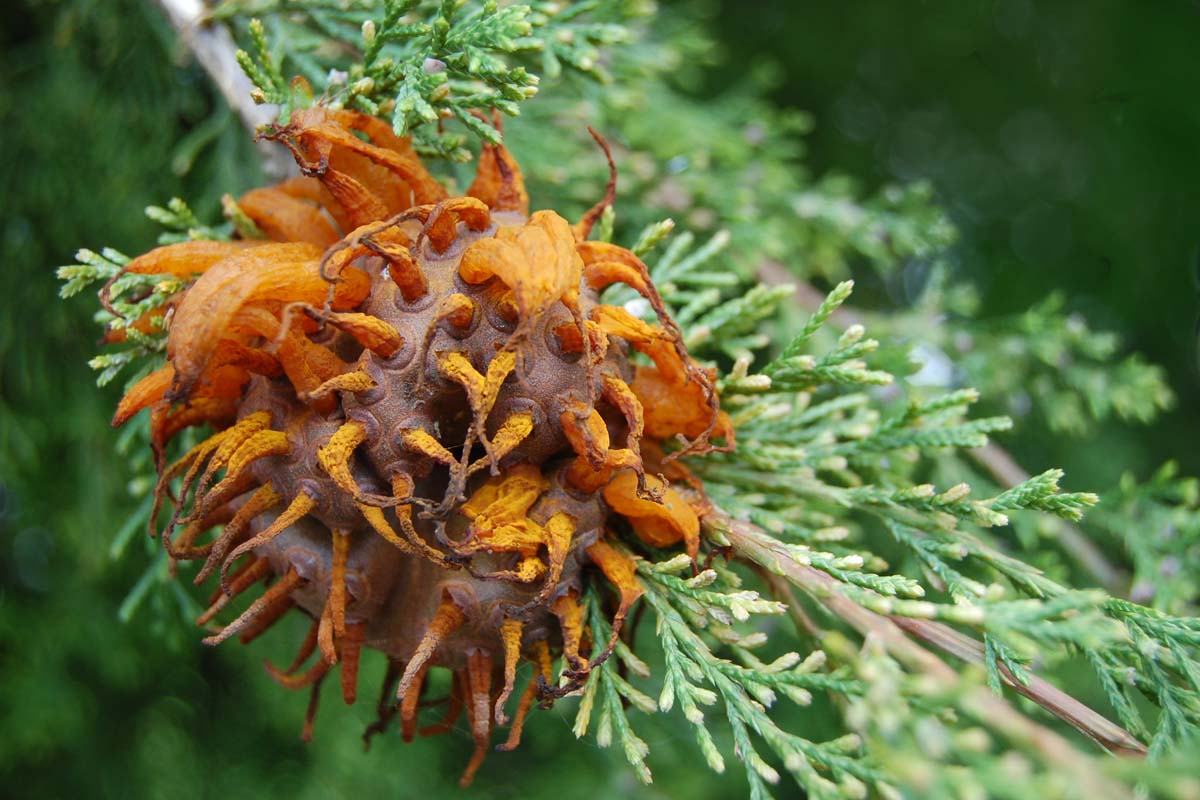
With these tips from Gardener’s Path, you have hope of tamping down the cedar apple rust on your apple or crabapple trees.
Leave a comment if you have dealt with this nasty fungus and let us know how it turned out for you. Have any more tips to suggest? Sharing is caring!
Read on for more tips about apple diseases:

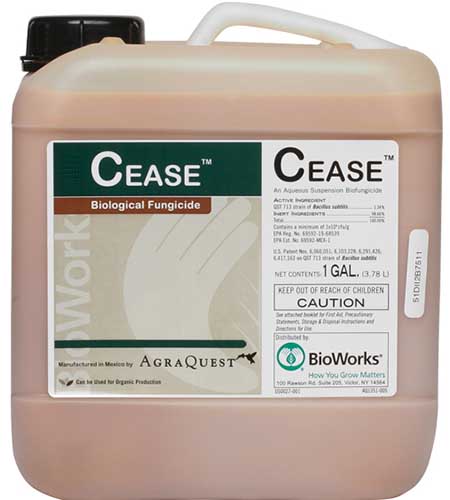
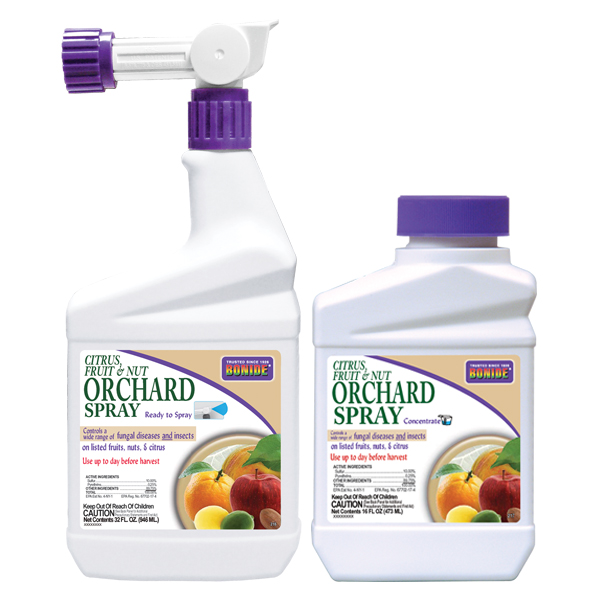
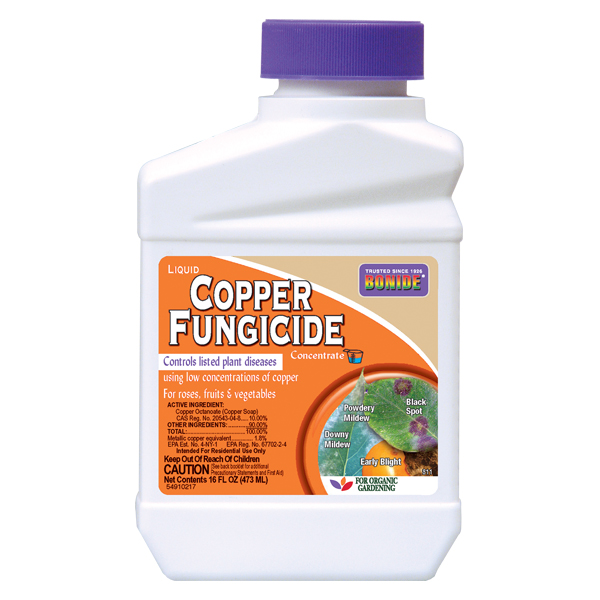
I have no idea how old this article is, but hope I can get an answer here. We want to plant some apple trees, we had tried Golden delicious, and having no experience with any fruit trees, they were seriously attacked by cedar rust. We live in SC zone 7b. I’ve looked at Liberty and see it’s pretty rust resistant. So I tried to find cross pollinators. From what I understand it’s a triploid. So I will need 3 different kinds of apples? Can you clear up anything I’ve been misinformed about and recommend what other tree or trees, I… Read more »
Dear LeAnn, I am so sorry that you are having such a terrible problem with cedar apple rust! I do not know the answer to your question, but I will consult with some apple professionals early next week and should have an answer for you soon. And thank you for giving your hardiness zone! Many people don’t think to do that. Sincerely, Helga George
Hi LeAnn, Triploids have three different sets of chromosomes (as opposed to the usual two that diploids have) and they are not the best providers of pollen for cross-pollination. Look for other apple trees that bloom at the same time to plant in close proximity to these, and see our articles on growing apples and recommended varieties for more information. I checked with my uncle Norm Schultz, farm manager at Linvilla Orchards in Media, PA. He had this information to share: “‘Sansa’ is a good scab resistant variety that ripens early, which will be beneficial to any home gardener. The… Read more »
I’m trying to layout a new/renew landscape in mountains of NC. To solve a drainage issue the 1 ton concrete blocks were put in. Homeowners want plants to hangover these, however they just had me put in 8 old-time apples. Cedar is a generic term. I see in your discussion all types of juniper are out. question what about Thuja, Cryptomeria, cotoneaster, Chamacyparis
Some google sites disallow those also but I’m wondering if they are actually alternate hosts
Thanks!
Hi Beverly! Thanks for your question. Thuja occidentalis is not an alternate host for cedar apple rust. It seems like your best bet to grow near the apple trees. Cotoneaster is an alternate host for another type of rust that infects apple (cedar quince rust), while Alaska yellow cedar is an alternate host for crabapple rust in the Pacific Northwest. I couldn’t find any information on Cryptomeria. Best of luck with the project!
Thanks so much
Good article. Pix on the apple trees look like a lot of other funguses nibbling on apple trees. Can you identify it short of a microscope? E.g. with a 10x hand lens?
Hi Sherwood, Yes – most leaf spots do look alike. However, the ones for cedar apple rust are unusual with the rust color surrounding the yellow spots. I don’t think that close visual inspection will help at this stage. However, later in the season, if you look underneath the spots, you will see brownish cylindrical tubes with hairs sticking out of them.
Thank you, that was great. I feel more informed. Do you know how to safely dispose of a very infected tree? It is a little over 50 feet from an apple tree that showed signs of infection last year. This will be the second cedar I have had to remove. I cut that one and dragged it in sections on tarps to burn at a nearby fire pit… How much damage am I doing by disturbing these spores? Am I being too cautious about bits dropping on lawn? And is burning releasing spores into atmosphere? Thank you so… Read more »
Hi Lyndie, I am so glad that you found the article helpful. I admire your diligence in removing the cedars! The only time you have to worry about spreading spores is when the cedar has those distinctive galls. Otherwise, I think you should be fine during the process of removal. The bits on the lawn should be fine. This kind of fungus requires a living host. It’s not one of those pathogens that will survive in debris on the ground. That’s a great question, though! That’s also an excellent question about releasing spores from burning. I just had a conversation… Read more »
Once I see the yellow/orange spots is it too late for spray? Should I remove all of those affected leaves 90% of tree)? Or can the spray heal those affected leaves?
I can send pix of affected leaves. Thanks!
Hi Evan, I’m so sorry to hear about your tree(s). Unfortunately, it is too late to cure the infection once you see the yellow/orange spots on the tree. Yes, you should focus on removing all of the infected leaves. Otherwise, they will spread more spores and make the infection even worse later in the season. Since you now know that the tree has an infection, you should definitely treat it in the spring when the fungi are susceptible. One product that you can use next spring is Bonide Liquid Copper Fungicide. I hope that helps.
Thanks so much! Some of the leaves are drying up and turning brown. Some branches are fine and others have all leaves in5 that branch drying up. Is that the effect of the orchard spray (bonide orchard spray) and is a normal part of the healing process? Or does it mean the tree needs more water? ????
Are there any posts that talk about what happens/what to expect after spraying and removing damaged leaves, etc? Thanks again!
Hi Evan, Forgive me if this is a duplicate post. The original seems to have vanished! No, we don’t have any articles on treatment after the fact. We usually focus on the initial treatment. Bonide should not have that effect on your tree. The fact that it is some branches and not others that are drying up doesn’t sound like a watering problem to me. I am concerned that something else might be going on. It almost sounds like it could be fire blight. Could you possibly post a picture? I would like to dig into this more deeply. Fire… Read more »
These photos were from about a week and a half ago. The yellow leaves have now dried up and are gone. I’ll take a new pic this weekend to show that.
Thanks for your help!
Actually, I was just able to snap these pics this afternoon…
Any ideas would be appreciated
Hi Evan,
Thank you so much for posting the pictures. Your poor tree! Actually, it’s good to have the current ones and the ones from before. It looks to me like the culprit is cedar apple rust, after all. There isn’t much you can do for treatment right now, but definitely treat the trees in the spring as I described in the previous post. The one good thing is that that disease does not usually kill apple trees, and I’m glad it’s not fire blight, which is a very nasty pathogen!
Thanks for your input. I’m clearly relieved! Is there any benefit in pruning off the branches that had the dead leaves? Or should I expect that next year, even those branches should have new healthy leaves?
Thanks so much!
Hi Evan,
Thanks! Me, too.
I definitely suggest leaving the branches. They should grow new leaves next year. Be sure and get rid of the infected leaves, though. Throw them out or burn them – don’t put them in your compost pile. Otherwise, they will spread the disease in the spring. Next year should go a lot better for your apple tree!
This spring I planted 2 bareroot dwarf appletrees in my back yard. Unfortunately, my neighbors on both sides have 40 foot red cedar/junipers, and one of my young trees, the 2-year Pixie Crunch, has developed rust on the lower leaves. (The other, a one-year Sundance, is not affected.) I can easily remove the affected leaves, but I worry that this might kill the tree since it so young. I removed the blossoms because I wanted the tree to put energy into growing rather than fruiting, and it has grown about a foot since planting. Should I remove the diseased leaves… Read more »
Hi Mary Jo,
I’m so sorry that your apple tree is infected with cedar apple rust. Yes – you should definitely remove the diseased leaves. If you don’t, the fungus will generate a lot of spores later in the year and spread the infection. Spraying at this point won’t help, but it will be critical to spray in the spring. The previous post in response to Evan’s question has the details on that, along with an organic copper fungicide that you can use. I wish you the best in fighting this infection!
We just moved here (central KY) last summer, so this is our first full growing season with the established apple tree in our yard. Last August, the tree had lots of apples and no signs of problems on the leaves. This spring/summer, all of the leaves seem to be affected. The tree also has only a couple of apples growing. (I am chalking this up to either several frosts in the first 2 weeks of May, or the fact that we did some major pruning around the beginning of November as it had obviously not been trimmed in any way… Read more »
Hi Stephanie,
I’m so sorry to hear that your tree is so badly infected. Yes – there is not much you can do to control it once those kinds of symptoms appear. I would encourage you to remove at least some of the leaves. They will serve as a source of spores to spread the infection. And treat aggressively come spring! Rusts don’t normally kill their hosts, but in severe cases, they can weaken an apple tree enough to kill it.
Now that it’s Spring, we have treatment of our apple tree in mind. We don’t want to harm pollinators–is liquid copper alone sufficient, or should it be used in addition to something else (such as the Serenade garden disease control)? Also, we planted 2 new apple trees and a pear tree (can this affect pears?) last Fall. Should we treat them as well, or just the tree that was affected last year? And for the future, once a tree has been affected, do you just treat it every Spring as a preventative since you know the cedar trees must be… Read more »
Hi Stephanie, Thank you so much for your questions! 1) Liquid copper should be sufficient if you start treatment early. It is generally safe for pollinators, but don’t apply it when the bees are actively foraging. 2) Pear are vulnerable to one kind of rust – cedar-hawthorn rust. I don’t think it would hurt to treat them to be safe. 3) I think you are right to ask about treating your apple trees preventatively. If your orchard has a history of cedar apple rust infections, you should definitely treat your new trees. They are also vulnerable to the disease. It… Read more »
We have treated our trees 3 times this Spring with liquid copper. The new trees (2 apple and 1 pear) look okay, but the established apple tree that was infected last year started developing spots on some of the leaves about a week ago, at which time we sprayed it again with liquid copper, and the spots have gotten worse since then (see attached photo taken today). Only some of the leaves seem to be affected at this point–generally the ones higher up on the tree. Is it possible that I misidentified the problem and it is something else? Or… Read more »
I not see any pictures of apples with the scabs, so I am posting pics of my apples to get some help.
Hi Heidi,
I’m so sorry that your apples are disfigured. Unfortunately, it’s too late in the year to treat the infection. You need to treat it in the spring.
Your best bet now is to remove the infected fruit and leaves and get them out of your garden/orchard.
The article offers a number of options for treatment for when next year rolls around.
Hope that helps!
Thank for for this informative post. We planted a McIntosh apple tree this year along with various crabapples – Adirondack, Sugar Tyme, and we had an existing Firebird crabapple That has been here several years now and it’s a beautiful specimen. We we got the Adirondack from a nursery about an hour south. We got the sugar Tyme from a local box store. We just learned about cedar apple rust after noticing the adirondacks being infected not long after planting sometime in July. Could they have already been infected from the nursery? My Sugar Tyme planted early spring does not… Read more »
Hi Kim, We’re so glad you liked the article! It sounds like you have quite the orchard. I think your best option is a biofungicide that will have no effect on pollinators, butterflies, and birds. A good option that is effective against cedar apple rust is Serenade Garden Disease Control. If you can’t find it locally, you can order it from Amazon. It contains a very well studied strain of Bacillus subtilis and has been used extensively in biocontrol. Here’s an article on these bacteria if you want to read more about them. By the way, I envy you your… Read more »
Hi Helga, I was wondering if maybe you could help me with a question that I am struggling with? My husband and I are wanting to buy a few apple trees, but we have Leyland Cypress trees on our property near where we are wanting to plant our apple trees. I have not been able to find much on Cypress trees dealing with the Cedar Apple Rust. So my question is, can Cypress trees be a problem for apple trees?
Hi Samantha,
Thank you so much for your question! According to the National Gardening Association, Leyland cypress is not on the list of alternate hosts for cedar apple rust, so you should be safe in planting your apple trees.
I hope they thrive for you!
Thank you! 🙂
Hi Samantha,
You are very welcome! We are always happy to help whenever possible. It’s kind of you to take the time to thank us.